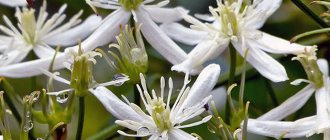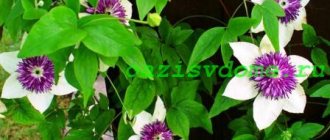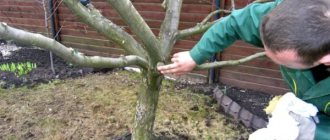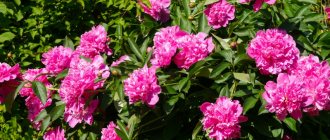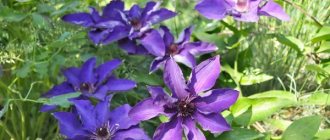Description of magnolia Sulange
The Sulanja variety is one of the most spectacular varieties of magnolias. Depending on the subspecies, Sulanja magnolia is a tree or shrub 2–10 m in height with a loose spherical crown. Magnolia Soulange is characterized by a short trunk with branches growing almost from the ground. The leaf blade is light green, large, matte, smooth on the surface, pubescent on the underside. In autumn the leaves fall.
This variety is characterized by moderate winter hardiness, which increases with the age of the plant. At very low winter temperatures, sometimes flower buds freeze, but this does not affect the health of the tree.
Another advantage of the variety is its resistance to environmental pollution, thanks to which the plant can be used for landscaping large cities and planted on the territory of industrial enterprises.
Botanical description
- The plant is a tree-like shrub or tree, from 2-3 to 8 m high, with a spreading crown of a round or pyramidal shape;
- The root system of this plant is well branched, the main part of the roots is located in the surface layer of soil;
- Low branches with smooth curves and beautiful bark grow almost from the ground;
- The flowers are large, cup-shaped or goblet-shaped (somewhat similar to tulips), up to 25 cm in diameter, with a unique aroma that can be easily felt even from a distance. The color of the flowers, depending on the variety, can be pure white, soft pink, purple, red and even two-color. This type of magnolia blooms very early - in April-May. In a warm spring, flowering can begin even in March.
- The leaves are oval, obovate, with pointed tips, pale green in color, glossy on the front side, matte and covered with villi on the back;
- Inedible fruits are multi-leaflets (collected leaflets), similar in appearance to coniferous cones. Ripen in September-October. The seeds are large, oval in shape.
On a note. A feature of this culture is the abundant appearance of flowers first, and then foliage. In this case, flowers occupy most of the shoots.
Magnolia Sulanja
In addition to the beauty of abundant flowering, the popularity of this type of magnolia is also given by such a characteristic as winter hardiness - the plant can withstand frosts down to -250C without damaging flower and leaf buds or cracking the bark.
Despite its resistance to frost, Magnolia Sulanja is grown mainly in the southern regions with a mild subtropical climate (Black Sea coast, Krasnodar Territory).
Important! Cultivation of certain types of magnolia is also possible in temperate climates. So, if you type “magnolia flower growing in the Moscow region” into a search engine, you can find videos telling how to grow and care for this beautiful plant in the conditions not only of the outskirts of Moscow, but also of Siberia and the Far East.
Types and varieties of magnolia Sulange
Magnolia variety Soulangeana was obtained by the French breeder Etienne Soulange as a result of crossing the Nude and Lily-colored magnolia varieties. Now about 20 forms of this plant have been bred, differing in the appearance of the flowers, crown shape and other characteristics.
Alexandrina
The magnolia tree Sulanja Alexandrina grows to a height of up to 6 m with a crown width of about 4 m. The variety is valuable for its large, up to 15 cm, odorless flowers with a double color: the inside of the petals is white, the outside is dark pink, almost purple. Flowers bloom in early May at the same time as the foliage. Magnolia variety Sulanzha Alexandrina is distinguished by very abundant, but short-lived - up to 3 weeks - flowering.
Galaxy
The tree of this variety has a straight trunk and a pyramidal, narrow crown shape. Magnolia Sulanja Galaxy blooms in late spring with purple or deep red fragrant flowers. Flowering is long and abundant. This tree looks best in small gardens.
Princess of Dreams
Magnolia Sulanja Princess of Dreams is a small, up to 5 m, shrub that blooms in the second half of spring. The corolla is very large, reaches 25 cm in diameter, and can have a goblet or cup shape. The inside of the petals is white, the outside color can be red, pink, purple or pink with white stripes. Thanks to its abundant flowering, unusual colors, delicate aroma and extraordinary size of flowers, this variety looks incredibly attractive.
Alba Superba
The magnolia tree Sulanja Alba Superba reaches a height of 4 m. The variety is distinguished by large flowers of especially delicate colors: the pink tint at the base of the corolla gives way to pure white. The flowers are goblet-shaped. Abundantly white flowers bloom even before the leaves appear, in April, but even later, against the backdrop of bright green young foliage, they look very picturesque.
Rustica Rubra
A variety of magnolia Sulanja Rustica Rubra is a tree or shrub with a wide crown, reaching a height of 7 m. It feels good in warm sunny areas, prefers moist, fertile soils. The variety blooms with large, goblet-shaped, rounded flowers. The outside of the corolla is painted red-pink, the inside is delicate white and pink. Flowering begins in the second half of spring, when the branches are not yet covered with foliage.
Linnaeus
This subspecies is particularly winter hardy and slow growing. Compact, no more than 2 - 3 m in height shrub, blooming in late spring. The dark purple buds open into large flowers, the inner surface of which is painted white. The flower petals of this variety are convex and fleshy.
Jenny
The magnolia bush of the Jenny variety is narrow, compact, reaches a height of about 3 m and a width of 1.5 m. It has surprisingly beautiful flowers, reminiscent of a tulip, with a dark red-ruby color, unusual for varieties of this crop. Flowering begins in April and continues for several weeks. Often at the end of summer there is a re-blooming, almost no different in abundance from spring.
Andre Leroy
Magnolia variety Sulanja Andre Leroy is a small spreading tree up to 4 m high. It blooms in late spring with elongated, medium-sized flowers with a subtle delicate scent. The corollas are bright, pink-violet, and look extremely picturesque both at the beginning of flowering on bare branches and after the foliage appears.
Classification
The magnolia species Sulanja includes more than 2 dozen varieties. Description of the most decorative of them:
- Alba Superba - the plant reaches a height of 3-5 meters. Large green leaves turn yellow in autumn. Delicate white inflorescences bloom in early May before the foliage appears. They look like tulips and emit a pleasant aroma.
- Alexandrina - a feature of this variety is its spreading crown. Large, goblet-shaped pink-purple flowers (up to 15 centimeters in diameter) bloom in May at the same time as the leaves.
- Lennei is a slow-growing magnolia bush, reaching a height of 5-6 meters. The inflorescences are large and dark purple on the outside. The branches of this variety do not freeze even in severe frosts.
Important! In order not to be disappointed with the result, you need to purchase planting material from nurseries or from trusted sellers .
Reproduction methods
The easiest way to propagate a shrub is vegetatively: cuttings, layering and grafting, but you can also grow magnolia Sulange from seeds.
When cutting cuttings, temperature and air humidity are very important. Young trees obtained in this way can be planted in a permanent place only after a year.
It is very easy to get new plants using layering. One or more lower branches of the mother bush are fixed to the soil and dug in, which stimulates the formation of roots. After a maximum of 2 years, the young plant can be separated from the main bush.
Propagation of magnolia variety Sulanzha by grafting is a relatively simple method, but it requires certain preparation and knowledge of technology. It consists of a rootstock of a bud of the desired type to a tree of a different variety. As a rule, amateur gardeners rarely use this method.
Seeds are sown in autumn. The prepared seed material is sown in boxes and put away in a cold place, in the spring they are taken out and the emerging seedlings are carefully looked after.
Use in landscape design
Magnolia Sulanja is a fairly large planting, so it will look good in single plantings against the background of a lawn. Under the canopy of its crown, you can place shade-loving plants: hostas, creeping conifers, ferns. In addition, the bushes are grown in tubs, which, if necessary, are moved to the place needed for decoration.
On a note. A plant grown in a pot will tolerate transplantation into open ground well throughout the season. .
Growing magnolia Soulange is not difficult, you just need to take into account the superficial location of its roots, as well as the fact that at a young age it does not tolerate midday sun. By caring for it throughout the season, the gardener will be able to admire the beautiful flowering of the plant in early spring, at a time when many plants are just beginning to form flower buds.
Planting and caring for magnolia Sulange
Regardless of the chosen variety of magnolia Sulanja, the beauty and health of plants depends on proper planting and proper care.
Recommended timing
Magnolia variety Sulanzha is planted in early spring or autumn. Many gardeners argue that it is preferable to plant it in October rather than in April, since there is a risk of frost returning in the spring. If a young seedling has already begun to flow sap, even short-term frosts can cause serious damage.
Site selection and soil preparation
Magnolia is a southern plant, so it prefers well-lit areas without drafts. However, you should avoid exposing the bush, especially young seedlings, to direct sunlight. The crop does not tolerate stagnant moisture; low-lying swampy areas or areas with high groundwater levels, less than 1.2 m from the surface, are unsuitable for it. From an aesthetic point of view, it is better to place the Soulange magnolia separately from other plantings in order to emphasize its beauty.
Attention! Magnolia does not tolerate transplantation well, so you need to choose a place for it with special care.
The soil for magnolias should be fertile, loose, well-permeable to water and air. Sandy and loamy soils with acidity close to neutral or slightly acidic are well suited. If magnolia is to be planted in limed soil, then during autumn digging, acidic peat is added to it.
Soil preparation involves digging spacious planting holes with a volume 2 to 3 times the size of the seedling's root ball. A mixture of turf soil, sand and peat or compost is placed on the bottom.
How to plant magnolia Soulange
For planting, it is better to choose a seedling with a closed root system. The landing procedure is as follows:
- the plant is placed in the center of the prepared hole and covered with a pre-prepared substrate, periodically compacting the soil;
- the top layer of soil is left loose;
- the seedling is thoroughly watered with warm water;
- after some time, when the soil around the plant settles, add more soil so that moisture does not accumulate around the trunk.
The distance between plantings is calculated depending on the characteristics of the variety, taking into account that mature trees do not shade each other. Typically, magnolia seedlings are not placed closer than 2–3 m from each other.
Subtleties of cultivation
Many gardeners believe that Sulange magnolia is delicate and capricious, and do not plant it on their plots. But if you choose the right place for it and care for it in accordance with its requirements, the culture will respond with the flowering of beautiful, fragrant buds.
How to choose a landing site
A correctly chosen planting location is one of the main conditions for the growth and development of magnolia. The crop should be planted in an area protected from wind and midday sun. The older the magnolia, the less sensitive it is to bright sunlight, but it does not tolerate transplantation well, so it must be planted in a permanent place immediately.
Pit preparation and soil requirements
The soil in which magnolia is planted should be light, loose, neutral or slightly acidic. It is made up of the following components: garden soil, rotted manure, compost, peat, sand, wood ash. Planting a seedling is done as follows:
- a hole is dug with a diameter twice the size of the root system of the planting;
- a drainage layer of 15-20 centimeters consisting of broken bricks, expanded clay, and small stones is laid at its bottom.
- a layer of sand (up to 15 centimeters) is spilled on top of the drainage, then the prepared substrate;
- A plant is planted in the center of the hole.
See also
Features and description of bush chrysanthemums of the Jordi variety, planting and careRead
The surface of the tree trunk circle is compacted a little and watered abundantly.
Landing Features
Since the roots of magnolia Sulange are shallow and superficial, the ground around it needs to be mulched with peat and then with the bark of coniferous trees. It is better to plant plants in the fall: during this period they are in relative peace, which contributes to their rapid establishment and good wintering.
Advice! The seedling in the container is first moistened with water, and then removed and planted in the ground together with the lump. .
Growing rules
If a suitable place is chosen for the magnolia variety Sulanzha and planting is carried out according to all the rules, further care of the plant is not particularly difficult. Young plants need increased attention for several years after planting, but with age they become more hardy and unpretentious.
Watering
The shrub is very sensitive to soil moisture, especially the first few years after planting. On hot days, the circles around the trunk should not be allowed to dry out, but in general, watering should be plentiful and frequent. It is usually sufficient to irrigate the soil every other day. You should use warm, preferably rain, water for this. On particularly hot days, crown sprinkling is used.
Attention! Stagnation of water is also detrimental to the magnolia root system, as is drying out of the soil.
Top dressing
Young magnolia begins to be fertilized at the age of three. This is done twice a year: in the spring, when the plant is preparing for the growing season, and in the first half of summer. You can use ready-made complexes for magnolia, or you can prepare a fertilizer based on cow manure, mixing it with urea and ammonium nitrate.
It should be remembered that excessive fertilization is harmful to the plant.
Trimming
Magnolia does not need formative pruning, but in early spring it is necessary to remove all dry, damaged and frozen branches, as well as branches bending inside the crown. The cut area must be treated with garden varnish.
Preparing for winter
Magnolia Sulange trees and shrubs are frost-resistant; some varieties easily tolerate winter temperatures down to -30 °C, so they are easy to grow in the middle zone, for example, in the Moscow region. Only young trees need shelter for the winter during the first few seasons after planting.
Attention! With age, magnolia becomes more and more frost-resistant.
To protect the plantings from frost, the tree trunks are mulched with spruce branches, sawdust or straw, and the plant itself is covered with burlap. Remove the shelter at a stable positive air temperature.
Agrotechnics of cultivation
Magnolia: tree
Regardless of what variety of Magnolia Sulange is purchased, only proper planting and care will turn a small seedling into a beautiful and strong plant.
Landing
To plant this crop, choose a place that most fully meets the following requirements:
- Lighting – well-lit places protected from cold winds and drafts are suitable for magnolia. At the same time, this plant should not be planted in full sun, since at the initial stage of growth the seedling may not withstand the constant high temperature and die. The crop will also grow poorly in low and swampy places in the spring or during the summer.
- Soil - the soil of the site for planting magnolia should be loose, fertile, and have a close to neutral reaction of the environment (neutral acidity pH = 6.5-7). This ornamental crop grows best on cohesive sandy and loamy soils, underlain by sand and sandy loam.
- Groundwater level - since the surface root system of magnolia is suppressed by flooding with groundwater, its maximum level during the season should be at a depth of at least 120 cm.
Magnolia is planted in early spring
In a plot selected according to these criteria, magnolia is planted in early spring, after the soil has thawed and melt water has drained, or in the fall (in October). Planting is carried out in holes with a diameter of 1 m and a depth of 30-40 cm. A mixture of fertile (turf) soil, low-lying peat and well-decomposed compost in a ratio of 2:1:1 is poured onto the bottom of the hole before planting. The seedling is placed in the center of the hole so that its roots rest on a mound of nutrient soil mixture poured onto the bottom. The hole with the seedling is gradually filled up, compacting the soil adjacent to the roots. To avoid moisture evaporation, the top layers of soil in the pit are not compacted, leaving them in a loose state. After planting, the seedling is watered with warm water from a watering can.
Important! Do not pour all the soil into the hole at once. Part of it should be left for filling - after a while the soil in the planting hole will compact and settle, thereby forming a depression near the seedling. If it is not covered, excess moisture may accumulate in it, which, if left stagnant for a long time, will inhibit the growth and development of the young plant.
If you plan to plant several varieties, the distance between them in a row is selected taking into account the diameter of their crown and the height of the adult plant. This is necessary so that in the future neighboring plants do not touch their branches and minimally shade each other. On average, the distance between different varieties should be 2-3 m. When planting several rows, the row spacing should be from 3 to 5 m.
Watering
Magnolia Sulanja is a moisture-loving plant. It should be watered quite often, using warm rainwater. When watering, you should carefully ensure that all the moisture is absorbed and there is no stagnation near the plant. The frequency of watering is once every 2 days. No more than 20 liters of water are poured under one plant at a time.
Watering is especially important in the summer heat - at this time, the crop is irrigated using garden sprayers installed next to the bushes so that small drops of moisture fall on the leaves.
Watering is important
Loosening the soil
Since most of the horses are located in the surface layer of the soil, the soil near the plant should be loosened to a minimum depth (2-3 cm). To avoid damage to the roots, you should not dig up or deeply loosen the soil of the plant; all weeds should be removed by hand.
Mulching
To mulch this crop, lowland peat and compost are used. Cover the soil with a layer of mulch in early spring, after surface loosening and moderate watering. In the future, the mulch is periodically updated. A permanent layer of mulch during the warm season should be at least 5 cm thick.
Feeding
The young plant is not fed for the first two years. Starting from the 3rd year, during the warm season two feedings are performed:
- The first feeding is done in early spring, during the awakening of the buds. It ensures more uniform and lush flowering and active plant growth.
- The second feeding is carried out in the summer (until mid-July). It is necessary so that the bark on young shoots becomes stronger and they do not freeze out during the winter.
Fertilizing is carried out with such complex fertilizers as:
- AGRECOL “For magnolia” – 40-50 g/m2;
- “Unevarsalnoe” Kimira – 80-100 g/m2.
When fertilizing, fertilizers are evenly scattered around the plant and incorporated during loosening.
Trimming
Magnolia Sulanja is pruned only in the spring. At the same time, thin tips damaged by severe frosts are removed, branches that touch each other grow inside the crown, thickening it. Also, all dried and wind-broken shoots must be cut out.
Pest and disease control
The main disease affecting the magnolia bush is chlorosis. It appears on the leaves in the form of yellow spots. The causes of chlorosis are alkaline soil, stagnation of excess moisture in the root zone, and flooding of the root system with groundwater. To combat this disease, alkaline soils are acidified with high-moor peat and pine litter. If the causes of chlorosis are flooding with groundwater and poor soil permeability, the plant is transplanted to another location.
Magnolia disease
The main pests that directly or indirectly damage the plant are:
- Spider mites infest magnolia and other flower crops especially heavily in dry, hot weather. Settling on the leaves, it sucks the juices out of them. Damaged shoots do not grow, weaken and may freeze during the winter. To combat spider mites, magnolia is sprayed with acaricides such as Aktelik, Aktara, Fitoverm, Omite, Fufanon.
- Rodents - gnaw at the root collar of a young seedling and damage the bark. Injured areas are treated with garden varnish. To combat rodents, magnolia roots are covered after the first frost - in frozen soil, rodents cannot make nests and damage the plant during the winter.
- Moles - when making their passages, moles often gnaw at the roots of magnolia, causing weakening and often death of the plant. To combat them, ultrasonic or homemade repellers are used, traps and traps are placed in the soil, and mole holes that come to the surface are filled with water.
Pests and diseases
The magnolia variety Sulanja is resistant to diseases and pests, however, this crop may also have health problems.
Chlorosis can be suspected by the appearance of yellow leaves with green veins. It occurs due to the high content of lime in the soil. You can cope with this disease by acidifying the soil with peat.
In hot weather, magnolia can be affected by spider mites, which feed on its juices. Acaricides are used to combat them.
Rodents and moles are not specific pests of this crop; they can harm any tree. To prevent them from settling in the roots of plants, with the onset of the first frosts, the tree trunk circles are covered, then in winter the plantings will not be damaged. Special ultrasonic repellers help against moles.
Diseases and pests
In general, Sulanja rarely gets sick or is attacked by insects. However, improper care can cause some problems:
- Yellow spots on the leaves indicate iron deficiency and the development of chlorosis . In this case, increasing the acidity of the soil and treating with iron chelate will help.
- Powdery mildew and spotting are treated with fungicides (Switch, Skor, etc.).
- Sometimes magnolia is attacked by spider mites , which causes the leaves to fall. A solution of laundry soap or spraying with insecticides will help in the fight.
- Quite often the trunk and roots are damaged by rodents . The wounds of the tree are treated with paraffin oil or an insecticide, and rodents are destroyed at the same time.
Magnolia Sulanja is well adapted to the climate of the middle and southern zone, so there will not be any special problems in care. It is important to choose the right place for planting and prepare the soil, and protect it from frost in the first few years. A strengthened plant will require a minimum of attention and will delight you with colorful spring blooms.
Magnolia after flowering
Magnolia 2, Dzhemete
How to care after flowering
Magnolia begins to bloom in spring or at the beginning of summer. Magnolia, covered with flowers, is the queen among garden trees. After the plant has flowered, it will need to be pruned for sanitary purposes. To do this, you need to cut off all faded flowers, as well as injured and frost-damaged branches and stems, as well as those growing inside the crown. Non-flowering magnolia is also very decorative, as it has beautiful leathery leaf blades.
Wintering
Preparing the plant for winter should begin in late autumn. The shelter must be good and reliable, since even if you grow a winter-hardy magnolia species, it can still freeze, especially if the winter is windy and with little snow. To prevent the plant from freezing, its trunk should be wrapped in 2 layers of burlap, while trying to ensure that the delicate branches are not injured. After the first frost, the surface of the tree trunk circle needs to be mulched with a thick layer.
Helpful information
You can buy magnolia in the Moscow region
Gardening tools, equipment for planting magnolia
— Fiskars Solid series shovel; — Gardena gloves for working with soil; — Samurai KS pruning shears, — OBI garden watering can.
Magnolia in bloom is an extraordinary sight. You want to admire and look at it when fabulous white flowers, like shining stars, bloom against the backdrop of the still empty garden. Magnolia brings out the tropical notes of spring in an ornamental garden. At the same time, she is unpretentious in care. Requires only watering in hot weather and shelter for the winter.
My experience of growing magnolia in the Moscow region
With the appearance of the Lebner magnolia variety Leonard Messel , I began to actively collect information about this plant. It was meager, but I decided to take a risk and plant an overseas miracle in my garden without any hope of success.
| It turned out that in my garden in the northern Moscow region it showed miracles of winter hardiness and frost resistance. |
I purchased a small seedling, about 30 cm tall.
- In the third year, the plant pleased with its first flowers.
- From the fifth year of life, magnolia began to actively increase in growth.
- After 8 years, my magnolia reached a height of 1.2 m, having released shoots 30 cm long in just the past year.
Every year there are more and more flowers. They are quite large, slightly smaller than the palm of your hand, and bloom profusely. The flowers are large, with characteristic thin indented petals and a typical southern center: a greenish pistil and yellowish stamens. The aroma is practically not felt.
I first saw magnolia in the apothecary botanical garden in Moscow about 12 years ago.
Huge white and pink flowers in the shape of water lilies against the background of dark leafless trunks looked fantastic.
At first there could be no thought about placing a southern beauty in the garden. However, desire turned out to be stronger than common sense.
The timing of magnolia flowering depends on weather conditions. If the spring is early and warm, magnolia can bloom in the 3rd decade of April ; in a prolonged spring, magnolia blooms in the beginning, or even in mid- May .
Photo: magnolia in my garden
Magnolia varieties for planting in the Moscow region
One of the most spectacular magnolias is Siebold , grandiflora , liliaceae , Soulange and naked . Unfortunately, varieties of these groups are not winter-hardy in the Moscow region.
But magnolia Kobus , star and Loebnera tolerate cold temperatures down to -40 ° C well and bloom under the condition of simple shelter for the winter.
- Their flowers are somewhat inferior compared to large-flowered magnolias.
- The flowers have more rugged petals and are slightly smaller in size than the large-flowered varieties.
- The size and growth of trees is more restrained, which is beneficial for the gardener when providing shelter.
Magnolia looks beautiful as a tapeworm in landscape design. Spectacular bushes are planted against the background of the lawn.
Planting magnolia in the Moscow region
Successfully growing magnolia is all about choosing the right planting location. The best time for planting in the Moscow region is spring.
Landing place
Magnolia can grow in both sun and partial shade. The main thing is that the place for planting the decorative bush is protected, especially from the north.
| In my garden, the magnolia from the north is protected by a wooden fence, and lilac and hazel grow on both sides of it. |
Soil for magnolia
Magnolia prefers moist soil and does not tolerate dry lands. Therefore, peat bogs, for example, are most preferable for it.
In addition, the soil must be fertile, I add to the planting hole:
- 1 bucket of compost,
- 1/2 cup bone meal,
- 2 tbsp. complex mineral fertilizer.
Planting a magnolia seedling
- Before planting magnolia, I soak the seedling in a bucket of sodium humate solution for about half a day, or overnight.
- I take the plant out of the pot and straighten the roots with a hoe.
- I lower the plant into the planting hole, pour in about a liter of water and cover it with soil.
- After planting, the seedling needs to be shaded.
Photo: magnolia flower bud in autumn
Caring for magnolia in the Moscow region
Magnolia is an unpretentious plant; it does not require special care. A real find for a gardener.
Watering and mulching
In the spring I mulch the tree with compost. During the season I water on dry days.
Feeding
- At the end of August I feed it with a solution of double superphosphate, two spoons per bucket of water.
- The fertilizer must first be dissolved in a small amount of hot water; in cold water, double superphosphate peas take a long time to dissolve.
- I don’t feed the magnolia with anything else throughout the entire season.
Diseases and pests
During the entire period of growing magnolia, I did not notice any pests or diseases on it.
Photo: box for covering magnolia
Planting magnolia in open ground
What time to plant
It is not possible to grow magnolia in every region. When choosing a place to plant it, you should take into account that this plant is very light-loving. Choose a well-lit area away from tall trees and provide the plant with good protection from east and north winds. Magnolia can be grown in slight shade only in the southern regions. The soil on the site should not be too saline or limescale, and excessively wet, sandy or heavy soil is not suitable. Slightly acidic or neutral soil saturated with organic matter is best suited. When purchasing material for planting, you should remember that the height of the seedling should be about 100 centimeters, it should have 1 or 2 buds. It is very good if the seedling has a closed root system, this will completely prevent it from drying out. A magnolia seedling with a closed root system can be transplanted into open soil in spring, summer, and autumn.
Most experts advise planting magnolia in open soil in the autumn in the second half of October. At this time, the seedling is already dormant. According to statistics, almost 100 percent of seedlings planted in the fall take root. In spring, seedlings are planted in the garden in April, but it should be remembered that even slight night frosts cause significant harm to established trees.
How to plant correctly
The size of the hole for planting magnolia must necessarily exceed the volume of the seedling's root system by 2 times. The top nutrient layer of soil that remains after digging a hole must be combined with rotted compost. If the soil is too dense, then a small amount of sand should also be added to it.
First, at the bottom of the pit you need to make a good drainage layer, the thickness of which should be from 15 to 20 centimeters; for this you can use crushed ceramic tiles or broken bricks. A fifteen-centimeter thick layer of sand is poured over the drainage. And a layer of pre-prepared nutrient soil mixture is poured onto the sand (the composition is described above). Then a seedling should be installed in the center of the hole, taking into account that after planting its root collar should rise 30–50 mm above the level of the site. Fill the holes with nutrient soil mixture and slightly compact the surface of the tree trunk circle. Planted magnolia needs abundant watering. After the liquid is completely absorbed into the soil, the surface of the tree trunk circle should be covered with a layer of peat, and a layer of dry coniferous tree bark should be placed on top of it. Mulching the soil will prevent it from drying out too quickly.
Magnolia propagation
Magnolia can be propagated by seeds, as well as layering, cuttings and grafting. But it should be taken into account that in order to preserve the varietal characteristics of the plant, it must be propagated exclusively by vegetative means. However, when growing magnolia from seeds, it is often possible to obtain a new variety, form or variety. And the generative method of reproduction is the simplest.
Propagation by seeds
Seeds ripen in September. Collect the fruits and place them on a piece of paper. Then the seeds are shaken out and immersed in a container of water, where they should remain for 2 to 3 days. Then they are rubbed through a sieve, so you can remove the papillae. Next, the seeds are washed in a soapy solution, which will remove the oily coating from them, and then they are thoroughly rinsed in clean running water. Seeds need to be stratified before sowing. To do this, they are placed in a polyethylene bag, which must be filled with moistened sphagnum or sand (1:4). Place the package on the middle shelf of the refrigerator for at least 20 days.
Stratified seeds must be removed from the refrigerator; place them in a fungicide solution for disinfection for a while. Then the seeds are placed in moistened moss and wait until they hatch. If everything is done correctly, the sprouts will produce more than half of the seeds. If you neglect stratification, then there will not be so many seedlings.
Make a groove 20 mm deep and place the seeds in it, which must be covered with a centimeter layer of substrate. This plant has a taproot system, so for sowing you need to take a high container, the depth of which will be at least 0.3 m. Transplantation into open ground is carried out after the threat of return frosts has passed, and the seedlings must be carefully transferred into the holes. For wintering, young bushes should be covered completely with dry peat.
Cuttings
To prepare cuttings, you need to choose young plants, and you need to have time to cut them before the buds open. It is best if the lower part of the cutting is woody and the upper part is green. The cuttings are planted in the last days of June or the first days of July; a greenhouse is used for this, since it will be possible to maintain the required temperature and humidity of the air and soil. The cuttings are planted in sand or a mixture consisting of peat, vermiculite, sand and perlite. The air temperature in the greenhouse should be kept at 20–24 degrees, in which case the cuttings will be able to take root within 5–7 weeks. If you take a cutting from a large-flowered magnolia, you should take into account that its rooting may take 2 times longer. Try to keep the air temperature within the recommended range. The fact is that if it is cooler, the rooting of cuttings will slow down significantly, and temperatures exceeding 26 degrees can destroy the plant. While the cuttings are in the greenhouse, do not forget to systematically ventilate it, and also make sure that the soil in it is always slightly moist.
How to propagate by layering
Reproduction by layering is suitable only for bush magnolias. In spring, you need to choose a branch that grows very close to the surface of the soil. At the base you need to tighten it with soft copper wire, then the branch is bent to the ground and fixed in this position. In the place where the branch comes into contact with the soil, it needs to be sprinkled with soil so that a small mound is formed. To speed up the appearance of roots, you need to make a circular cut on it in the place where the branch touches the ground.
Air layering is sometimes used for propagation. In the last spring or first summer weeks, you need to select a branch and make a circular cut of the bark on it, the width of which should be from 20 to 30 mm. The cut must be made carefully so as not to injure the wood. Next, the cut is treated with Heteroauxin, and then the wound is covered with moistened moss and wrapped with cling film, which must be secured below and above the cut site. After this, this branch is tied to nearby branches, which will avoid injury due to strong gusts of wind. The moss should be a little damp all the time. To do this, several times a month you need to “inject” water into it through a syringe. Roots should appear after 8-12 weeks. In autumn, the cuttings should be disconnected from the mother plant, and they should be grown indoors.
How to plant magnolia
Lobelia ampelous planting and care, photo
Magnolia is not very demanding, but when planting and caring for it, you must follow some simple rules, which, first of all, relate to the composition of the soil, watering and fertilizing.
Soil composition
It is best to purchase magnolia seedlings in well-established specialized stores. They are usually sold there in containers. Such plants tolerate both spring and autumn planting well, since they are planted with a clod of earth to which they have already adapted. Experienced gardeners recommend purchasing plants 1 m tall with a couple of already blooming flowers for planting.
This way you will know for sure that your local climate is suitable for this type of magnolia.
The soil for planting should be light, well-drained and moderately moist. Neutral or slightly acidic soil rich in organic matter is ideal.
Important! Calcareous and saline soil is contraindicated for magnolias.
If the soil on your site is limed, then you can add peat to it, which will increase the acidity.
Optimal soil composition:
- deciduous or turf soil – 1;
- peat – 2;
- sand – 0.5.
Magnolias planting scheme
The hole for planting should be prepared in advance, 3-5 times larger than the root system of the tree. Drainage is poured at the bottom of the hole - 15 cm high. Then a layer of sand (10 cm), a layer of manure (15 cm), again a layer of sand (15 cm) and the prepared soil mixture are laid. After this, the seedling is placed in a hole and covered with earth, making sure that the root collar is not buried. The maximum recommended depth is 2.5 cm. The soil should be lightly compacted and watered abundantly. The tree trunk area can be covered with pine bark, which will help maintain the required level of moisture.
Magnolia does not tolerate transplants, so it must be immediately planted in a permanent place. If you plan to plant several trees, then the distance between them should be at least 4-5 m.
Types of magnolias and their characteristics
Gardeners often call magnolia the most aristocratic tree, and this is not at all in vain. Seeing magnolia with its beautiful leaves, large and fragrant flowers, you are unlikely to confuse it with another plant. Currently, there are more than 100 varieties of magnolia trees and shrubs.
Magnolias are bushes and trees with a height of 2 meters. The foliage is elliptical or reverse ovoid. Large bisexual flowers reach a diameter of 20-25 cm, usually placed one at a time at the very edge of the shoot. The color can be anything - white, pink, cream, purple, yellow, violet - it all depends on the variety you choose. The flowers give off a most pleasant, delicate aroma.
It is customary to divide magnolias into two types: evergreen and deciduous.
Evergreens grow in warmer zones where the temperature difference in winter is less significant.
deciduous varieties of magnolia are usually grown .
In most cases, early flowering varieties: Kobus (lat. Kobus), Loebner magnolia (lat. Magnolia loebneri) - a hybrid of star magnolia (lat. Magnolia stellata) and Kobus., Soulangiana magnolia (lat. Soulangiana) begin to awaken at the end of March ( when the air temperature starts to hover around +10 degrees). Then the first buds appear (mid-April). When the temperature exceeds 15-25 degrees, magnolias will begin to bloom abundantly, which will amaze you with its beauty and aroma.
Magnolia flowers
In mid-May, the following varieties begin to bloom : Watson (lat. Watson), Wilson (lat. Wilson), Siebold (lat. Sieboldii) and Ash (lat. Ashei) . The flowers of these magnolia varieties bloom one at a time, which significantly prolongs the flowering process, unlike those that bloom in early spring.
The duration of flowering cannot be determined accurately, because each species has its own biological characteristics and age. Changing factors include climate conditions and care.
Choosing the time and place of landing
Disembarkation time
If you bought your magnolia in a container or pot, it can be replanted from mid-March to the end of September. The method of planting a plant from a pot (container) is most preferable, because it is planted with a small amount of soil to which it is accustomed. In this case, the plant adaptation occurs much faster.
Landing place
Before planting the plant, you need to study the microclimate of the garden or area where you are going to plant the magnolia. Lighting plays a huge role in successfully growing magnolias. As you know, these plants are quite heat-loving, but young plants cannot stand the scorching sun at midday: the result of “overheating” may be leaves of a light yellow color.
Planting a magnolia tree in the Moscow region
If you plant a magnolia in a less sunny place, the level of green pigment increases. That is why the plant should be planted in the shade of another tree. In the image above, a magnolia tree was planted in the floor shade of pine trees, a good solution, the pine trees will not only provide shade to the floor, but also slightly acidify the soil with their fallen pine needles.
As for air pollution, the varieties Kobus (lat. Kobus) and magnolia Soulangiana (lat. Soulangiana) cope well with a large percentage of emissions from enterprises and car exhaust gases.
General landing rules
Magnolia should be planted in light and slightly moist soil.
Watering and loosening
In the very first year, it became clear to me that under no circumstances should the magnolia root system be over-watered, although it is believed that magnolia cannot be waterlogged. Abundant watering does not harm mature plants, but not young ones. In young magnolias, the roots simply rot from excess moisture during the cool period, even in loose and breathable soil. During the hot period, when waterlogged, the roots will simply “cook” in the ground, since most of them are located superficially. In addition, the delicate (one- and even two-year-old) bark of a young magnolia that has absorbed an excessive amount of moisture in the heat suffers greatly from sunburn.
The following picture is observed: at the site of the burn, the bark dries out, and then over the course of a week, the entire green branch above the burn gradually dries up. Magnolia Siebold leaf
For me, leaves . If they have a bright color (it can be green in adults and initially green or brown-red in young leaves of some varieties), then it is enough to moisten the soil around the magnolia well (3-5 liters of water).
Young leaves of Loebner magnolia
If the color of the leaves fades or begins to fade into green-yellow shades, watering must be done in an increased volume (5-7 l).
I water magnolias once every 1-2 weeks, exclusively in the evening . I do not loosen often and to a depth of only 1-2 cm; I usually limit myself to manual weeding.
I periodically remove weeds from under the plant.
Pruning and propagation
Another advantage of magnolia sulanja is the ease of pruning the bush. Despite the fact that the crown can be shaped, most gardeners limit themselves to sanitary cleaning.
Figure 5. Pruning allows you to preserve the decorative nature of the crop
Magnolia should be pruned in early spring, before sap begins to flow in the branches. At this time, remove all branches damaged by frost, as well as shoots growing inside the crown and thickening it. All dry and broken branches must also be removed (Figure 5).
You should dwell in more detail on the propagation of shrubs. In its natural environment, magnolia reproduces by self-seeding, and young seedlings grow from seeds that have fallen to the ground. At home, preference should be given to vegetative methods - cuttings and rooting of layering.
